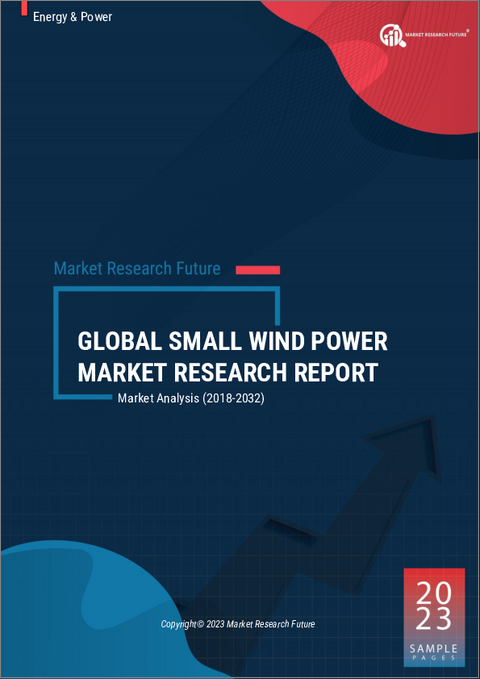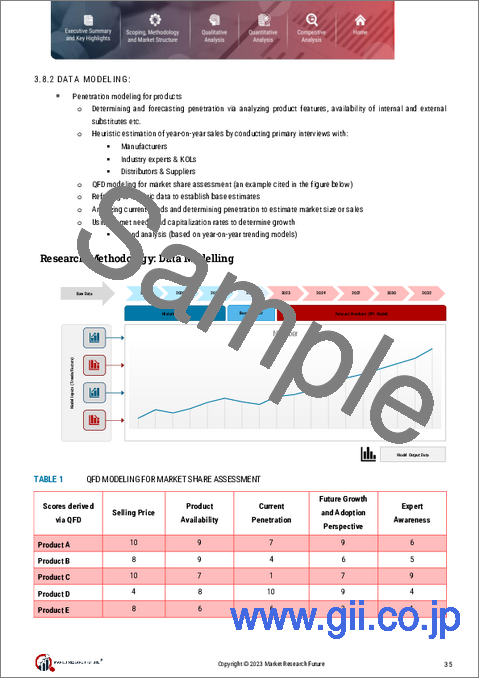|
|
市場調査レポート
商品コード
1596043
小型風力発電の世界市場:グリッド接続 (オングリッド・オフグリッド)・軸 (水平・垂直)・容量 (2KW未満・2~5KW・5~10KW)・地域別の予測 (~2032年)Global Small Wind Power Market Research Report Information by Grid Connectivity (On-Grid and Off-Grid), By Axis (Horizontal and Vertical), By Capacity (Up to 2KW, 2KW to 5KW, and 5KW to 10 KW) and By Region Forecast to 2032 |
||||||
|
|||||||
| 小型風力発電の世界市場:グリッド接続 (オングリッド・オフグリッド)・軸 (水平・垂直)・容量 (2KW未満・2~5KW・5~10KW)・地域別の予測 (~2032年) |
|
出版日: 2024年11月08日
発行: Market Research Future
ページ情報: 英文 143 Pages
納期: 即納可能
|
全表示
- 概要
- 図表
- 目次
小型風力発電の市場規模は市場規模は、2022年の56億3,000万米ドル、2023年の64億9,871万米ドルから、予測期間中は14.33%のCAGRで推移し、2032年には216億8,806万米ドルの規模に成長すると予測されています。
小型風力発電事業は、エネルギーコストの上昇、環境への配慮、技術の飛躍的進歩などを背景に、近年劇的に拡大しています。小型風力タービンは、大規模な風力発電所とは対照的に、分散型で発電を行い、個々の住宅、農場、小規模企業、遠方の町に電力を供給します。特に送電網への接続が不可能な場所やコストのかかる場所では、エネルギーの自立と地域の回復力を高めることができます。これらのタービンは、風の運動エネルギーを取り込み、発電機に接続されたブレードの回転によって電気に変えます。この特性により、安定した再生可能エネルギーを供給できるため、オフグリッドのコテージや農業、送電網の接続が不安定な地域にとって特に魅力的です。
利用可能なタービンのサイズ、デザイン、用途の幅広さは、市場の多様性を示しています。タービンの選択は、風力資源のアベイラビリティ、エネルギー消費量、スペース上の制限、予算などの要因に影響されます。技術の飛躍的進歩により、小型風力タービンの効率と信頼性は大幅に向上しました。設計、材料、製造方法における革新は、より静かな運転、より高いエネルギー収量、より低いメンテナンス要件をもたらし、小型風力発電を太陽光発電などの他の再生可能エネルギーに代わる実行可能な選択肢としています。
地域別インサイト
アジア太平洋市場は最大のシェアを持ち、予測期間中もかなりの収益シェアを占めると予測されています。同地域の小型風力発電産業には、沿岸部、山地、島嶼部などさまざまな地形に分布する大規模な風力資源など、さまざまな利点があります。アジア太平洋地域の政府は再生可能エネルギーへの支援を強化しており、小型風力発電の展開を奨励する法律、インセンティブ、補助金を提供しています。固定価格買取制度、税制優遇措置、再生可能エネルギー目標など、こうした取り組みが業界の拡大を後押ししています。さらに、この地域のいくつかの国では、急速な経済拡大と都市化によってエネルギー消費が増加しています。小型風力発電は、化石燃料への依存度を下げ、環境への懸念を軽減しながら、この増大するニーズに応える方法を提供します。
当レポートでは、世界の小型風力発電の市場を調査し、市場の定義と概要、市場成長への各種影響因子の分析、市場規模の推移・予測、各種区分・地域/主要国別の内訳、競合環境、主要企業のプロファイルなどをまとめています。
目次
第1章 エグゼクティブサマリー
第2章 市場概要
第3章 調査手法
第4章 市場力学
- 促進要因
- 政府の有利なインセンティブと政策
- エネルギー安全保障と回復力に関する懸念の高まり
- 小型風力タービン技術の継続的な進歩
- 抑制要因
- 高額の初期資本投資が必要
- 規制と許可に関する課題
- 機会
- オフグリッドおよび遠隔地用途に対する需要の増加
- 都市化と分散型エネルギーシステムへの焦点の移行
- 課題
- 世間の認識と受容
第5章 市場要因分析
- サプライ/バリューチェーン分析
- ポーターのファイブフォース分析
- COVID-19の流行が世界の小型風力発電市場に与える影響
第6章 世界の小型風力発電市場:グリッド接続別
- オングリッド
- オフグリッド
第7章 世界の小型風力発電市場:軸別
- 水平
- 垂直
第8章 世界の小型風力発電市場:容量別
- 最大2KW
- 2~5KW
- 5~10KW
第8章 世界の小型風力発電市場:地域別
- 概要
- 北米
- 欧州
- アジア太平洋
- 中東・アフリカ
- 南米
第10章 競合情勢
- 市場シェア分析
- 競合ベンチマーキング
第11章 企業プロファイル
- WEG ELECTRIC CORP
- BERGEY WINDPOWER CO.
- SENWEI ENERGY TECHNOLOGY INC
- EOCYCLE TECHNOLOGIES INC
- GUANGZHOU HY ENERGY TECHNOLOGY LIMITED CORP
- CITY WINDMILLS
- AEOLOS WIND ENERGY LTD
- ENGIE
- ENERLICE
- ECO ENERG SOLUTIONS
LIST OF TABLES
- TABLE 1 GLOBAL SMALL WIND POWER MARKET, BY GRID CONNECTIVITY, 2018-2032(USD MILLION)
- TABLE 2 GLOBAL ON-GRID SMALL WIND POWER MARKET, BY REGION, 2018-2032(USD MILLION)
- TABLE 3 GLOBAL OFF-GRID SMALL WIND POWER MARKET, BY REGION, 2018-2032(USD MILLION)
- TABLE 4 GLOBAL SMALL WIND POWER MARKET, BY AXIS, 2018-2032(USD MILLION)
- TABLE 5 GLOBAL SMALL WIND POWER MARKET, HORIZONTAL, BY REGION, 2018-2032(USD MILLION)
- TABLE 6 GLOBAL SMALL WIND POWER MARKET, VERTICAL, BY REGION, 2018-2032(USD MILLION)
- TABLE 7 GLOBAL SMALL WIND POWER MARKET, BY CAPACITY, 2018-2032(USD MILLION)
- TABLE 8 GLOBAL SMALL WIND POWER MARKET, FOR UPTO 2KW, BY REGION, 2018-2032(USD MILLION)
- TABLE 9 GLOBAL SMALL WIND POWER MARKET, FOR 2KW TO 5KW, BY REGION, 2018-2032(USD MILLION)
- TABLE 10 GLOBAL SMALL WIND POWER MARKET, FOR 5KW TO 10 KW, BY REGION, 2018-2032(USD MILLION)
- TABLE 11 GLOBAL SMALL WIND POWER MARKET, BY REGION, 2018-2032(USD MILLION)
- TABLE 12 NORTH AMERICA: SMALL WIND POWER MARKET, BY COUNTRY, 2018-2032 (USD MILLION)
- TABLE 13 NORTH AMERICA: SMALL WIND POWER MARKET, BY GRID CONNECTIVITY, 2018-2032(USD MILLION)
- TABLE 14 NORTH AMERICA: SMALL WIND POWER MARKET, BY AXIS, 2018-2032(USD MILLION)
- TABLE 15 NORTH AMERICA: SMALL WIND POWER MARKET, BY CAPACITY, 2018-2032(USD MILLION)
- TABLE 16 U.S.: SMALL WIND POWER MARKET, BY GRID CONNECTIVITY, 2018-2032(USD MILLION)
- TABLE 17 U.S.: SMALL WIND POWER MARKET, BY AXIS, 2018-2032(USD MILLION)
- TABLE 18 U.S.: SMALL WIND POWER MARKET, BY CAPACITY, 2018-2032(USD MILLION)
- TABLE 19 CANADA: SMALL WIND POWER MARKET, BY GRID CONNECTIVITY, 2018-2032(USD MILLION)
- TABLE 20 CANADA: SMALL WIND POWER MARKET, BY AXIS, 2018-2032(USD MILLION)
- TABLE 21 CANADA: SMALL WIND POWER MARKET, BY CAPACITY, 2018-2032(USD MILLION)
- TABLE 22 MEXICO: SMALL WIND POWER MARKET, BY GRID CONNECTIVITY, 2018-2032(USD MILLION)
- TABLE 23 MEXICO: SMALL WIND POWER MARKET, BY AXIS, 2018-2032(USD MILLION)
- TABLE 24 MEXICO: SMALL WIND POWER MARKET, BY CAPACITY, 2018-2032(USD MILLION)
- TABLE 25 EUROPE: SMALL WIND POWER MARKET, BY COUNTRY, 2018-2032 (USD MILLION)
- TABLE 26 EUROPE: SMALL WIND POWER MARKET, BY GRID CONNECTIVITY, 2018-2032(USD MILLION)
- TABLE 27 EUROPE: SMALL WIND POWER MARKET, BY AXIS, 2018-2032(USD MILLION)
- TABLE 28 EUROPE: SMALL WIND POWER MARKET, BY CAPACITY, 2018-2032(USD MILLION)
- TABLE 29 GERMANY: SMALL WIND POWER MARKET, BY GRID CONNECTIVITY, 2018-2032(USD MILLION)
- TABLE 30 GERMANY: SMALL WIND POWER MARKET, BY AXIS, 2018-2032(USD MILLION)
- TABLE 31 GERMANY: SMALL WIND POWER MARKET, BY CAPACITY, 2018-2032(USD MILLION)
- TABLE 32 FRANCE: SMALL WIND POWER MARKET, BY GRID CONNECTIVITY, 2018-2032(USD MILLION)
- TABLE 33 FRANCE: SMALL WIND POWER MARKET, BY AXIS, 2018-2032(USD MILLION)
- TABLE 34 FRANCE: SMALL WIND POWER MARKET, BY CAPACITY, 2018-2032(USD MILLION)
- TABLE 35 U.K.: SMALL WIND POWER MARKET, BY GRID CONNECTIVITY, 2018-2032(USD MILLION)
- TABLE 36 U.K.: SMALL WIND POWER MARKET, BY AXIS, 2018-2032(USD MILLION)
- TABLE 37 U.K.: SMALL WIND POWER MARKET, BY CAPACITY, 2018-2032(USD MILLION)
- TABLE 38 ITALY: SMALL WIND POWER MARKET, BY GRID CONNECTIVITY, 2018-2032(USD MILLION)
- TABLE 39 ITALY: SMALL WIND POWER MARKET, BY AXIS, 2018-2032(USD MILLION)
- TABLE 40 ITALY: SMALL WIND POWER MARKET, BY CAPACITY, 2018-2032(USD MILLION)
- TABLE 41 ROE: SMALL WIND POWER MARKET, BY GRID CONNECTIVITY, 2018-2032(USD MILLION)
- TABLE 42 ROE: SMALL WIND POWER MARKET, BY AXIS, 2018-2032(USD MILLION)
- TABLE 43 ROE: SMALL WIND POWER MARKET, BY CAPACITY, 2018-2032(USD MILLION)
- TABLE 44 ASIA PACIFIC: SMALL WIND POWER MARKET, BY COUNTRY, 2018-2032 (USD MILLION)
- TABLE 45 ASIA PACIFIC: SMALL WIND POWER MARKET, BY GRID CONNECTIVITY, 2018-2032(USD MILLION)
- TABLE 46 ASIA PACIFIC: SMALL WIND POWER MARKET, BY AXIS, 2018-2032(USD MILLION)
- TABLE 47 ASIA PACIFIC: SMALL WIND POWER MARKET, BY CAPACITY, 2018-2032(USD MILLION)
- TABLE 48 CHINA: SMALL WIND POWER MARKET, BY GRID CONNECTIVITY, 2018-2032(USD MILLION)
- TABLE 49 CHINA: SMALL WIND POWER MARKET, BY AXIS, 2018-2032(USD MILLION)
- TABLE 50 CHINA: SMALL WIND POWER MARKET, BY CAPACITY, 2018-2032(USD MILLION)
- TABLE 51 INDIA: SMALL WIND POWER MARKET, BY GRID CONNECTIVITY, 2018-2032(USD MILLION)
- TABLE 52 INDIA: SMALL WIND POWER MARKET, BY AXIS, 2018-2032(USD MILLION)
- TABLE 53 INDIA: SMALL WIND POWER MARKET, BY CAPACITY, 2018-2032(USD MILLION)
- TABLE 54 JAPAN: SMALL WIND POWER MARKET, BY GRID CONNECTIVITY, 2018-2032(USD MILLION)
- TABLE 55 JAPAN: SMALL WIND POWER MARKET, BY AXIS, 2018-2032(USD MILLION)
- TABLE 56 JAPAN: SMALL WIND POWER MARKET, BY CAPACITY, 2018-2032(USD MILLION)
- TABLE 57 MALAYSIA: SMALL WIND POWER MARKET, BY GRID CONNECTIVITY, 2018-2032(USD MILLION)
- TABLE 58 MALAYSIA: SMALL WIND POWER MARKET, BY AXIS, 2018-2032(USD MILLION)
- TABLE 59 MALAYSIA: SMALL WIND POWER MARKET, BY CAPACITY, 2018-2032(USD MILLION)
- TABLE 60 SOUTH KOREA: SMALL WIND POWER MARKET, BY GRID CONNECTIVITY, 2018-2032(USD MILLION)
- TABLE 61 SOUTH KOREA: SMALL WIND POWER MARKET, BY AXIS, 2018-2032(USD MILLION)
- TABLE 62 SOUTH KOREA: SMALL WIND POWER MARKET, BY CAPACITY, 2018-2032(USD MILLION)
- TABLE 63 AUSTRALIA AND NEW ZEALAND (ANZ): SMALL WIND POWER MARKET, BY GRID CONNECTIVITY, 2018-2032(USD MILLION)
- TABLE 64 AUSTRALIA AND NEW ZEALAND (ANZ): SMALL WIND POWER MARKET, BY AXIS, 2018-2032(USD MILLION)
- TABLE 65 AUSTRALIA AND NEW ZEALAND (ANZ): SMALL WIND POWER MARKET, BY CAPACITY, 2018-2032(USD MILLION)
- TABLE 66 THAILAND: SMALL WIND POWER MARKET, BY GRID CONNECTIVITY, 2018-2032(USD MILLION)
- TABLE 67 THAILAND: SMALL WIND POWER MARKET, BY AXIS, 2018-2032(USD MILLION)
- TABLE 68 THAILAND: SMALL WIND POWER MARKET, BY CAPACITY, 2018-2032(USD MILLION)
- TABLE 69 ROAPAC: SMALL WIND POWER MARKET, BY GRID CONNECTIVITY, 2018-2032(USD MILLION)
- TABLE 70 ROAPAC: SMALL WIND POWER MARKET, BY AXIS, 2018-2032(USD MILLION)
- TABLE 71 ROAPAC: SMALL WIND POWER MARKET, BY CAPACITY, 2018-2032(USD MILLION)
- TABLE 72 MEA: SMALL WIND POWER MARKET, BY COUNTRY, 2018-2032 (USD MILLION)
- TABLE 73 MEA: SMALL WIND POWER MARKET, BY TYPE, 2018-2032(USD MILLION)
- TABLE 74 MEA: SMALL WIND POWER MARKET, BY END USE, 2018-2032(USD MILLION)
- TABLE 75 SAUDI ARABIA: SMALL WIND POWER MARKET, BY GRID CONNECTIVITY, 2018-2032(USD MILLION)
- TABLE 76 SAUDI ARABIA: SMALL WIND POWER MARKET, BY AXIS, 2018-2032(USD MILLION)
- TABLE 77 SAUDI ARABIA: SMALL WIND POWER MARKET, BY CAPACITY, 2018-2032(USD MILLION)
- TABLE 78 UAE: SMALL WIND POWER MARKET, BY GRID CONNECTIVITY, 2018-2032(USD MILLION)
- TABLE 79 UAE: SMALL WIND POWER MARKET, BY AXIS, 2018-2032(USD MILLION)
- TABLE 80 UAE: SMALL WIND POWER MARKET, BY CAPACITY, 2018-2032(USD MILLION)
- TABLE 81 SOUTH AFRICA: SMALL WIND POWER MARKET, BY GRID CONNECTIVITY, 2018-2032(USD MILLION)
- TABLE 82 SOUTH AFRICA: SMALL WIND POWER MARKET, BY AXIS, 2018-2032(USD MILLION)
- TABLE 83 SOUTH AFRICA: SMALL WIND POWER MARKET, BY CAPACITY, 2018-2032(USD MILLION)
- TABLE 84 ROMEA: SMALL WIND POWER MARKET, BY GRID CONNECTIVITY, 2018-2032(USD MILLION)
- TABLE 85 ROMEA: SMALL WIND POWER MARKET, BY AXIS, 2018-2032(USD MILLION)
- TABLE 86 ROMEA: SMALL WIND POWER MARKET, BY CAPACITY, 2018-2032(USD MILLION)
- TABLE 87 SOUTH AMERICA: SMALL WIND POWER MARKET, BY COUNTRY, 2018-2032 (USD MILLION)
- TABLE 88 SOUTH AMERICA: SMALL WIND POWER MARKET, BY GRID CONNECTIVITY, 2018-2032(USD MILLION)
- TABLE 89 SOUTH AMERICA: SMALL WIND POWER MARKET, BY AXIS, 2018-2032(USD MILLION)
- TABLE 90 SOUTH AMERICA: SMALL WIND POWER MARKET, BY CAPACITY, 2018-2032(USD MILLION)
- TABLE 91 BRAZIL: SMALL WIND POWER MARKET, BY GRID CONNECTIVITY, 2018-2032(USD MILLION)
- TABLE 92 BRAZIL: SMALL WIND POWER MARKET, BY AXIS, 2018-2032(USD MILLION)
- TABLE 93 BRAZIL: SMALL WIND POWER MARKET, BY CAPACITY, 2018-2032(USD MILLION)
- TABLE 94 ARGENTINA: SMALL WIND POWER MARKET, BY GRID CONNECTIVITY, 2018-2032(USD MILLION)
- TABLE 95 ARGENTINA: SMALL WIND POWER MARKET, BY AXIS, 2018-2032(USD MILLION)
- TABLE 96 ARGENTINA: SMALL WIND POWER MARKET, BY CAPACITY, 2018-2032(USD MILLION)
- TABLE 97 ROSA: SMALL WIND POWER MARKET, BY GRID CONNECTIVITY, 2018-2032(USD MILLION)
- TABLE 98 ROSA: SMALL WIND POWER MARKET, BY AXIS, 2018-2032(USD MILLION)
- TABLE 99 ROSA: SMALL WIND POWER MARKET, BY CAPACITY, 2018-2032(USD MILLION)
LIST OF FIGURES
- FIGURE 1 MARKET SYNOPSIS
- FIGURE 2 MARKET ATTRACTIVENESS ANALYSIS: GLOBAL MAGNET
- FIGURE 3 GLOBAL SMALL WIND POWER ANALYSIS BY GRID CONNECTIVITY, % SHARE, 2022, MARKET SIZE, 2018-2032
- FIGURE 4 GLOBAL SMALL WIND POWER ANALYSIS BY AXIS, % SHARE, 2022, MARKET SIZE, 2018-2032
- FIGURE 5 GLOBAL SMALL WIND POWER ANALYSIS BY CAPACITY, % SHARE, 2022, MARKET SIZE, 2018-2032
- FIGURE 6 GLOBAL SMALL WIND POWER ANALYSIS BY REGION,
- FIGURE 7 GLOBAL SMALL WIND POWER MARKET: MARKET STRUCTURE
- FIGURE 8 KEY BUYING CRITERIA OF SMALL WIND POWER REPORT
- FIGURE 9 BOTTOM-UP AND TOP-DOWN APPROACHES
- FIGURE 10 MARKET DYNAMIC ANALYSIS OF THE GLOBAL SMALL WIND POWER MARKET
- FIGURE 11 SUPPLY / VALUE CHAIN: GLOBAL SMALL WIND POWER MARKET
- FIGURE 12 GLOBAL SMALL WIND POWER MARKET, BY GRID CONNECTIVITY, 2022 (% SHARE), 2023 VS 2032 (USD MILLION)
- FIGURE 13 GLOBAL SMALL WIND POWER MARKET, BY AXIS, 2022 (% SHARE), 2023 VS 2032 (USD MILLION)
- FIGURE 14 GLOBAL SMALL WIND POWER MARKET, BY CAPACITY, 2022 (% SHARE), 2023 VS 2032 (USD MILLION)
- FIGURE 15 GLOBAL SMALL WIND POWER MARKET, BY REGION, 2021 (% SHARE) 2023 VS 2032 (USD MILLION)
- FIGURE 16 NORTH AMERICA: SMALL WIND POWER MARKET, BY COUNTRY, 2022 (USD BILLION)
- FIGURE 17 EUROPE: SMALL WIND POWER MARKET, BY COUNTRY, 2022 (REVENUE % SHARE)
- FIGURE 18 ASIA PACIFIC: SMALL WIND POWER MARKET, BY COUNTRY, 2022 (REVENUE % SHARE)
- FIGURE 19 MEA: SMALL WIND POWER MARKET, BY COUNTRY, 2022 (REVENUE % SHARE)
- FIGURE 20 LATIN AMERICA: SMALL WIND POWER MARKET, BY COUNTRY, 2022 (REVENUE % SHARE)
- FIGURE 21 MARKET SHARE ANALYSIS (2022, %) *
- FIGURE 22 GLOBAL SMALL WIND POWER MARKET: COMPETITIVE BENCHMARKING
Market Overview
The small wind power market was valued at USD 5,630.00 million in 2022. The Small Wind Power Market is expected to increase from USD 6,498.71 million in 2023 to USD 21,688.06 million in 2032, with a compound yearly growth rate (CAGR) of 14.33% during the forecast period (2023-2032). The small wind power business has expanded dramatically in recent years, driven by rising energy costs, environmental concerns, and technology breakthroughs. Small wind turbines, as opposed to large-scale wind farms, generate power on a decentralized basis, serving individual residences, farms, small enterprises, and distant towns. Their on-site installation improves energy independence and local resilience, especially in places where grid connection is unfeasible or expensive. These turbines capture the kinetic energy of the wind and turn it into electricity via blade rotation connected to a generator. This characteristic makes them especially appealing for off-grid cottages, agricultural activities, and regions with inconsistent grid connectivity, as they provide a consistent source of renewable energy.
The wide range of turbine sizes, designs, and applications available demonstrates the market's diversity. The choice of turbine is influenced by factors such as wind resource availability, energy consumption, space limits, and budget. Technological breakthroughs have significantly improved the efficiency and dependability of tiny wind turbines. Innovations in design, materials, and manufacturing methods have resulted in quieter operation, higher energy yields, and lower maintenance requirements, putting small wind power as a viable alternative to other types of renewable energy such as solar power.
Market Segment insights
The Small Wind Power Market has been divided into two segments based on small wind power grid connectivity: on-grid and off-grid.
According to Axis, the Small Wind Power Market is divided into two segments: horizontal and vertical.
The Small Wind Power Market is divided into three segments based on capacity: up to 2KW, 2KW to 5KW, and 5KW to 10KW.
Regional insights
The Small Wind Power market is divided into five regions: North America, Europe, Asia Pacific, the Middle East and Africa, and Latin America. The Asia-Pacific Small Wind Power market has the largest market share and is predicted to account for a sizable revenue share over the forecast period. The Asia-Pacific small wind power industry has various advantages, including significant wind resources distributed across different topography such as coastal areas, mountains, and islands. Governments in Asia-Pacific are increasingly supportive of renewable energy, providing laws, incentives, and subsidies to encourage small wind power deployment. These initiatives, which include feed-in tariffs, tax breaks, and renewable energy targets, are propelling industry expansion. Furthermore, fast economic expansion and urbanization in several nations in the region are increasing energy consumption. Small wind power offers a way to meet this growing need while lowering reliance on fossil fuels and mitigating environmental concerns. Furthermore, tiny wind power systems provide a decentralized and stable energy source, especially for isolated and off-grid communities in rural areas with restricted access to electricity.
Major Players
WEG Electric, Bergey Windpower Co., Senwei Energy, Eocycle Technologies Inc., Guangzhou HY Energy Technology Limited Corp., and others are among the small wind power market's key players.
TABLE OF CONTENTS
1 EXECUTIVE SUMMARY
- 1.1 MARKET ATTRACTIVENESS ANALYSIS
- 1.1.1 GLOBAL SMALL WIND POWER MARKET, BY GRID CONNECTIVITY
- 1.1.2 GLOBAL SMALL WIND POWER MARKET, BY AXIS
- 1.1.3 GLOBAL SMALL WIND POWER MARKET, BY CAPACITY
- 1.1.4 GLOBAL SMALL WIND POWER MARKET, BY REGION
2 MARKET INTRODUCTION
- 2.1 DEFINITION
- 2.2 SCOPE OF THE STUDY
- 2.3 MARKET STRUCTURE
- 2.4 KEY IMPLEMENTATION CRITERIA
3 RESEARCH METHODOLOGY
4 MARKET DYNAMICS
- 4.1 INTRODUCTION
- 4.2 DRIVERS
- 4.2.1 FAVORABLE GOVERNMENT INCENTIVES AND POLICIES
- 4.2.2 GROWING CONCERNS ABOUT ENERGY SECURITY AND RESILIENCE
- 4.2.3 CONTINUOUS ADVANCEMENTS IN SMALL WIND TURBINE TECHNOLOGY
- 4.3 RESTRAINTS
- 4.3.1 HIGH INITIAL CAPITAL INVESTMENT REQUIRED
- 4.3.2 REGULATORY AND PERMITTING CHALLENGES
- 4.4 OPPORTUNITIES
- 4.4.1 INCREASING DEMAND FOR OFF-GRID AND REMOTE APPLICATIONS
- 4.4.2 SHIFTING FOCUS TOWARDS URBANIZATION AND DISTRIBUTED ENERGY SYSTEMS
- 4.4 CHALLENGES
- 4.4.1 PUBLIC PERCEPTION AND ACCEPTANCE POSE A SIGNIFICANT CHALLENGE
5 MARKET FACTOR ANALYSIS
- 5.1 SUPPLY/VALUE CHAIN ANALYSIS
- 5.2 PORTER FIVE FORCES
- 5.2.1 THREAT OF NEW ENTRANTS
- 5.2.2 BARGAINING POWER OF SUPPLIERS
- 5.2.3 BARGAINING POWER OF BUYERS
- 5.2.4 THREAT OF SUBSTITUTES:
- 5.2.5 COMPETITIVE RIVALRY
- 5.3 IMPACT OF CORONAVIRUS OUTBREAK ON THE GLOBAL SMALL WIND POWER MARKET
- 5.3.1 OVERVIEW OF SUPPLY AND DEMAND SCENARIO
- 5.3.2 IMPACT OF COVID-19 ON SUPPLY CHAIN ANALYSIS
6 GLOBAL SMALL WIND POWER MARKET, BY GRID CONNECTIVITY
- 6.1 INTRODUCTION
- 6.2 ON-GRID
- 6.3 OFF-GRID
7 GLOBAL SMALL WIND POWER MARKET, BY AXIS
- 7.1 INTRODUCTION
- 7.2 HORIZONTAL
- 7.3 VERTICAL
8 GLOBAL SMALL WIND POWER MARKET, BY CAPACITY
- 8.1 INTRODUCTION
- 8.2 UPTO 2KW
- 8.3 2KW TO 5KW
- 8.4 5KW TO 10 KW
8 GLOBAL SMALL WIND POWER MARKET, BY REGION
- 9.1 OVERVIEW
- 9.2 NORTH AMERICA
- 9.2.1 U.S.
- 9.2.2 CANADA
- 9.3 EUROPE
- 9.3.1 GERMANY
- 9.3.2 U.K.
- 9.3.3 FRANCE
- 9.3.4 ITALY
- 9.3.5 REST OF EUROPE
- 9.4 ASIA-PACIFIC
- 9.4.1 CHINA
- 9.4.2 INDIA
- 9.4.3 JAPAN
- 9.4.4 MALAYSIA
- 9.4.5 SOUTH KOREA
- 9.4.6 AUSTRALIA AND NEW ZEALAND (ANZ)
- 9.4.7 THAILAND
- 9.4.8 REST OF APAC
- 9.5 MEA (MIDDLE EAST AND AFRICA)
- 9.5.1 SAUDI ARABIA
- 9.5.2 UAE
- 9.5.3 SOUTH AFRICA
- 9.5.4 ROMEA
- 9.6 SOUTH AMERICA
- 9.6.1 BRAZIL
- 9.6.2 ARGENTINA
- 9.6.3 ROSA (REST OF SOUTH AMERICA)
10 COMPETITIVE LANDSCAPE
- 10.1 MARKET SHARE ANALYSIS
- 10.2 COMPETITIVE BENCHMARKING
11 COMPANY PROFILES
- 11.1 WEG ELECTRIC CORP
- 11.1.1 COMPANY OVERVIEW
- 11.1.2 FINANCIAL OVERVIEW
- 11.1.3 TYPES AND SERVICES
- 11.1.4 SWOT ANALYSIS
- 11.1.5 KEY STRATEGIES
- 11.2 BERGEY WINDPOWER CO.
- 11.2.1 COMPANY OVERVIEW
- 11.2.2 FINANCIAL OVERVIEW
- 11.2.3 TYPES AND SERVICES
- 11.2.4 SWOT ANALYSIS
- 11.2.5 KEY STRATEGIES
- 11.3 SENWEI ENERGY TECHNOLOGY INC
- 11.3.1 COMPANY OVERVIEW
- 11.3.2 FINANCIAL OVERVIEW
- 11.3.3 TYPES AND SERVICES
- 11.3.4 NEELKANTH FINECHEM LLP: SWOT ANALYSIS
- 11.3.5 KEY STRATEGIES
- 11.4 EOCYCLE TECHNOLOGIES INC
- 11.4.1 COMPANY OVERVIEW
- 11.4.2 FINANCIAL OVERVIEW
- 11.4.3 TYPES AND SERVICES
- 11.4.4 SWOT ANALYSIS
- 11.4.5 KEY STRATEGIES
- 11.5 GUANGZHOU HY ENERGY TECHNOLOGY LIMITED CORP
- 11.5.1 COMPANY OVERVIEW
- 11.5.2 FINANCIAL OVERVIEW
- 11.5.3 TYPES AND SERVICES
- 11.5.4 SWOT ANALYSIS
- 11.5.5 KEY STRATEGIES
- 11.6 CITY WINDMILLS
- 11.6.1 COMPANY OVERVIEW
- 11.6.2 FINANCIAL OVERVIEW
- 11.6.3 TYPES AND SERVICES
- 11.6.4 SWOT ANALYSIS
- 11.6.5 KEY STRATEGIES
- 11.7 AEOLOS WIND ENERGY LTD
- 11.7.1 COMPANY OVERVIEW
- 11.7.2 FINANCIAL OVERVIEW
- 11.7.3 TYPES AND SERVICES
- 11.7.4 SWOT ANALYSIS
- 11.7.5 KEY STRATEGIES
- 11.8 ENGIE
- 11.8.1 COMPANY OVERVIEW
- 11.8.2 FINANCIAL OVERVIEW
- 11.8.3 TYPES AND SERVICES
- 11.8.4 SWOT ANALYSIS
- 11.8.5 KEY STRATEGIES
- 11.9 ENERLICE
- 11.9.1 COMPANY OVERVIEW
- 11.9.2 FINANCIAL OVERVIEW
- 11.9.3 TYPES AND SERVICES
- 11.9.4 SWOT ANALYSIS
- 11.9.5 KEY STRATEGIES
- 11.10 ECO ENERG SOLUTIONS
- 11.9.1 COMPANY OVERVIEW
- 11.9.2 FINANCIAL OVERVIEW
- 11.9.3 TYPES AND SERVICES
- 11.9.4 SWOT ANALYSIS
- 11.9.5 KEY STRATEGIES





